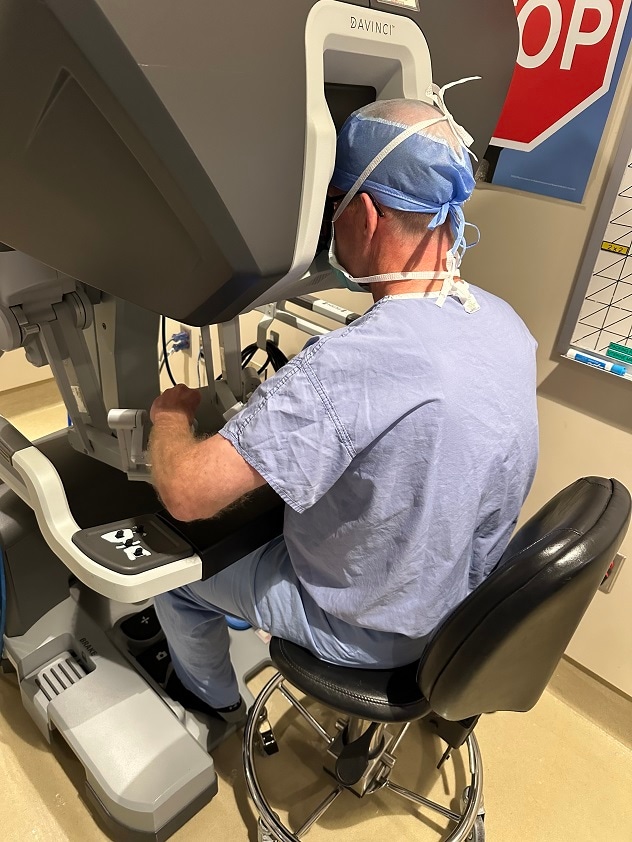Nov. 30, 2023
Mayo Clinic surgeons have successfully performed Minnesota's first robot-assisted kidney transplant. This minimally invasive procedure can benefit patients with higher BMIs and reduce the risk of incisional complications.
Timucin Taner, M.D., Ph.D., Transplantation Surgery division chair, and Patrick G. Dean, M.D., a kidney transplant surgeon, both at Mayo Clinic in Minnesota, performed the robot-assisted surgery. The recipient was a woman in her sixties whose daughter donated the kidney.
Beyond its uniqueness in the state, this patient's robotic kidney transplant was the first at any Mayo Clinic site. Mayo Clinic in Minnesota plans to expand robotic kidney transplant availability in the future, and Mayo Clinic in Arizona is exploring the potential for this type of transplant.
Distinctives of robotic kidney transplant
 Robot quirúrgico
Robot quirúrgico
El Dr. Patrick G. Dean, sentado en la consola que controla el robot quirúrgico.
When implanting the kidney in the robotic procedure, the surgeon does not stand over the surgical field and place hands inside the patient to directly perform tasks such as suturing and tying. The surgeon sits at a console and controls the surgical robot, creating small incisions and inserting the instruments through ports, similar to laparoscopic surgery. Surgical assistants, however, touch the patient and manipulate instruments inside the patient.
For patients, a robot-assisted kidney transplant offers these benefits:
- Smaller incisions. In this type of transplant, the surgeon creates an approximately 2-inch incision around the belly button and then a smaller incision to insert the robotic instruments. In traditional open kidney transplant, the surgeon creates a 4- to 8-inch incision.
- Lower incision option for cosmetic purposes. Robotic surgery affords the option to make lower incisions than those used for open kidney transplant surgery.
- Lower complication risk. The minimized incision in a robot-assisted kidney transplant lowers risk of complications such as hernia and infection.
- Faster recovery. A smaller incision with robot-assisted transplant implies that the patient will likely have less from which to heal, reducing recovery time and making possible a faster return to work and daily life activities.
- Reduced discomfort and hospitalization. This surgical technique's smaller incisions involve less discomfort for the patient. Reduced discomfort combined with speedier recovery time means that a patient usually leaves the hospital earlier than with open kidney transplant.
For surgeons performing the kidney transplant, a robot-assisted transplant offers these benefits:
- Relief from hours standing in surgery. In the robotic procedure, rather than standing over the patient to work in the surgical field, the surgeon sits at a console. A literature review published in Rehabilitation Nursing in 2015 found significant evidence that standing at work for prolonged periods is associated with multiple health risks. Surgeons can avoid these health risks if sitting for a robotic transplant.
- Visualization. This type of surgery allows the surgeon an enhanced view compared with the view using the surgeon's eyes alone.
"Robot-assisted kidney transplant will not replace open kidney transplantation entirely. It will, however, offer another option for those who may benefit from an alternative incision site."
Appropriate patients for robotic kidney surgery referral
For most patients, traditional open kidney transplant surgery remains the best option, says Dr. Taner, indicating that this type of kidney transplant has been safe and successful.
"Open kidney transplantation remains the gold standard," Dr. Taner says. "Robot-assisted kidney transplant will not replace open kidney transplantation entirely. It will, however, offer another option for those who may benefit from an alternative incision site."
Dr. Dean and Dr. Taner envision that patients who might benefit the most from robotic kidney transplant and would be appropriate for referral to Mayo Clinic are those with higher BMIs, especially individuals carrying weight around the central torso. If a patient's body habitus dictates that open surgery must penetrate very deeply into the abdomen, robotics can help avoid that surgical challenge by improving visualization. Robotic surgery's smaller incisions and faster and simpler recovery can help avoid incisional complications.
Robotic kidney transplant training
Dr. Dean, Dr. Taner and two of their colleagues spent approximately six months in training for robotic kidney transplant surgery. They participated in numerous simulations with videos, manikins, animal models and deceased donors. These various practice sessions helped them become proficient and comfortable with the procedure so they could perform it in a human transplant, says Dr. Taner.
Robotic kidney transplant's potential future
Dr. Dean believes that robotic kidney transplant will become more common in the coming years, especially because more instruments are now available for these operations.
"I don't think robotic surgery will ever account for the majority of kidney transplants, as certain patient characteristics won't make it the most preferable option," says Dr. Dean. "I do think robotic kidney transplant will be increasing, which is what we've seen across the country in the last couple of years."
For more information
Waters TR, et al. Evidence of health risks associated with prolonged standing at work and intervention effectiveness. Rehabilitation Nursing. 2015;40:148.
Refer a patient to Mayo Clinic.